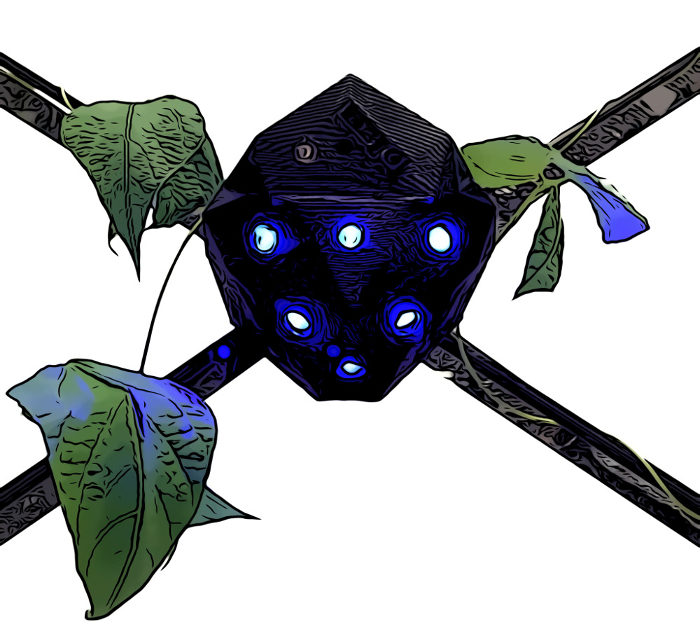flora robotica project

flora robotica: Societies of Symbiotic Robot-Plant Bio-Hybrids as Social Architectural Artifacts
The goal of the EU research project "flora robotica" is to develop intelligent plants. In the future, these intelligent plants - guided by swarms of robots - are to enliven our cities architecturally: From controlled green walls to entire houses made of living biomass. To achieve this, the international research team is developing so-called "biohybrid societies" of robot swarms and plants. Novel technologies developed in the project make it possible for the first time that humans, plants, and robots can communicate with each other at a high level and achieve common goals.
One of the major challenges in the "flora robotica" research project was to establish a communication network between natural plants, humans, and robots. To this end, the scientists have developed completely new communication channels that can influence both the short-term and long-term growth of the plants: The robots can tell the plants in which direction they should grow, and the plants can let the robots know what they need to do so (e.g., water or light).
Robots as interpreters between the human and plant worlds
However, the robots not only communicate with the plants, they also become mediators and interpreters between the human and plant worlds. For the first time, we humans can thus work in a structured, targeted, and planned manner on a completely new type of plant architecture. For the first time, researchers will receive information about the condition of plants (e.g., nutrient deficiencies) from the robots in "real time" and will be able to react to this before any negative effects on the plant can arise. Conversely, the researchers can also send information to plants via the robots, such as whether the plant is currently forming the respective desired architectural shape or needs to direct its growth differently.
Intelligent plants build sustainable livable environments
Robots are already being used to influence plant growth, for example in automated greenhouses. In flora robotica, the scientists are going a decisive step further: Their goal is to influence plant growth throughout and in this way create innovative new architectural structures. The robots will become a kind of "master builder" of a completely new type of plant architecture. In the future, the intelligent plants will help to build sustainable cities and living environments, from "living walls" to furniture and even entire houses. In flora robotica, however, architectural aesthetics also play an important role and new, permanently changing, resource-saving architectural systems are created.
Technology that makes "talking" to plants possible
Technically, the combination of a variety of sensors enables communication between robots and plants. These sensors work on the basis of available technology, such as simple proximity sensors and other optical sensors. In addition, however, the research team has also developed new technologies such as biomass sensors based on electromagnetic field distortion or transpiration sensors and sensors that measure sap flow (xylem sap flow). Some of the symbiotic robots are stationary, while others move slowly to keep up with plant growth. Fast-moving, on the other hand, are the robots' control mechanisms, which use high-intensity LEDs and vibration motors to influence the plants. Furthermore, the researchers used blue light to control the plants via so-called "phototropism" by attracting their growing tip to the light source. However, light in the so-called "far-red" range (between the spectrum of visible and infrared light) is also used to specifically repel plants. At the same time, vibration motors are used to restrict growth to certain sub-areas. In previous experiments, the interaction between robots and a variety of different plant species, such as bamboo, beans, bananas or tomatoes, has already been successfully tested.
The flora robotica team
The EU-funded research project "flora robotica" was launched in 2015 under the leadership of Prof. Dr.-Ing. Heiko Hamann with an interdisciplinary team of scientists from four different EU countries. On board are computer scientists, robotics experts, zoologists, cell biologists, mechatronics engineers and architects.
- Universität zu Lübeck (Institut für Technische Informatik)
- Adam Mickiewicz Universität, Polen (Fakultät für Molekular- und Zellbiologie)
- Centre for Information Technology and Architecture, Dänemark
- Cybertronica Research, Deutschland
- IT University of Copenhagen, Dänemark (Robotics, Evolution and Art Lab)
- Karl-Franzens-Universität Graz, Österreich (Fakultät für Zoologie, Artificial Life Lab)
This project is funded by the European Union's Horizon 2020 Research and Innovation Program under FET Grant Agreement No. 640959.

